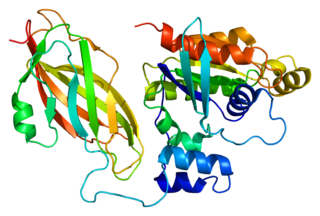
Cell division control protein 42 homolog is a protein that in humans is encoded by the Cdc42 gene. Cdc42 is involved in regulation of the cell cycle. It was originally identified in S. cerevisiae (yeast) as a mediator of cell division, and is now known to influence a variety of signaling events and cellular processes in a variety of organisms from yeast to mammals.

Rac1, also known as Ras-related C3 botulinum toxin substrate 1, is a protein found in human cells. It is encoded by the RAC1 gene. This gene can produce a variety of alternatively spliced versions of the Rac1 protein, which appear to carry out different functions.

Rac2 is a small signaling G protein, and is a member of the Rac subfamily of the family Rho family of GTPases. It is encoded by the gene RAC2.

Rho guanine nucleotide exchange factor 6 is a protein that, in humans, is encoded by the ARHGEF6 gene.

Partitioning defective 3 homolog is a protein that in humans is encoded by the PARD3 gene.

Partitioning defective 6 homolog alpha is a protein that in humans is encoded by the PARD6A gene.

Golgi-associated PDZ and coiled-coil motif-containing protein is a protein that in humans is encoded by the GOPC gene.

Cdc42-interacting protein 4 is a protein that in humans is encoded by the TRIP10 gene.

Ran-specific binding protein 1 is an enzyme that in humans is encoded by the RANBP1 gene.

Serine/threonine-protein kinase MRCK alpha is an enzyme that in humans is encoded by the CDC42BPA gene.

Cdc42 effector protein 3 is a protein that in humans is encoded by the CDC42EP3 gene.

Cdc42 effector protein 1 is a protein that in humans is encoded by the CDC42EP1 gene.

Formin-binding protein 1-like is a protein that in humans is encoded by the FNBP1L gene.

TC10/CDC42 GTPase-activating protein is an enzyme that in humans is encoded by the SNX26 gene.

EH-domain containing 2, also known as EHD2, is a human gene belonging to the EHD protein family.

Partitioning defective 6 homolog beta is a protein that in humans is encoded by the PARD6B gene.

Cdc42 effector protein 4 is a protein that in humans is encoded by the CDC42EP4 gene.

Cdc42 effector protein 2 is a protein that in humans is encoded by the CDC42EP2 gene.

GTPase activating protein and VPS9 domains 1, also known as GAPVD1, Gapex-5 and RME-6 is a protein which in humans is encoded by the GAPVD1 gene.

Rho-related GTP-binding protein RhoJ is a protein that in humans is encoded by the RHOJ gene.


























